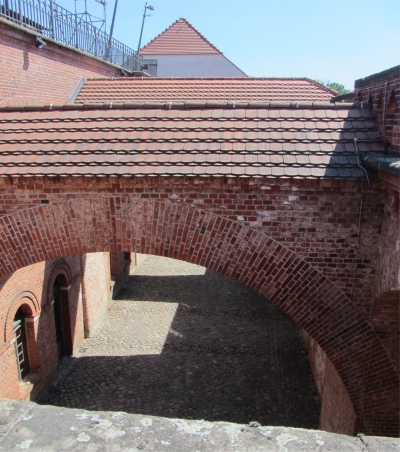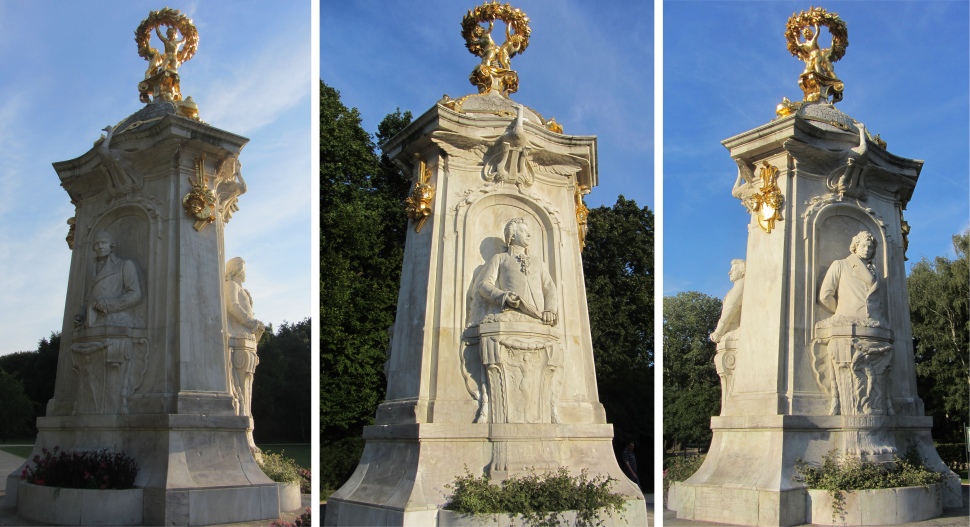
Italian Courtyards
|
Moving on along the yellow trail, we crossed a bridge spanning the River Havel. A lock was located a short distance along the river, with numerous watercraft piling into the lock as we watched. Much to Rex's disappointment we couldn't stand there all day waiting for the lock gates to close.
Instead, we crossed the bridge and turned off to the Spandau Citadel. On a little island in the Havel River, Spandau Citadel is considered the best preserved Renaissance fortification in northern Europe. Its moat, drawbridge and four arrowhead-shaped bastions make it a veritable textbook in military architecture. There has been a fort on this site since the 11th century. An exhibition in the gatehouse gave us a good account of the history of the Citadel.
The emblem of the citadel is the 30m high Juliusturm. Completed in 1230, the Julius Tower is one of the oldest surviving structures in Berlin. The walls of this giant were up to 3.6m thick in places, and in 1838 the current battlements were created by Karl Friedrich Schinkel - why not, he played a great architectural role in Berlin. Dan and I climbed the tower, which had served as a residential, defensive and state prison tower in its past, and from the battlements we were afforded splendid views of the surrounding watery area, indeed in the distance we could pick out the Fernsehturm in Berlin.
After a brief scan of the Bastion König, we all took a walk along curtain walls to the Bastion Kronprinz, enabling us to take in the architectural strength of this great fortress. After the experiences of the 30 years war, there was an expansion of the fortress to create a bastionären defence system. The citadel's current exterior was created at the end of the 16th century by Italian architects. A quadrangle of curtain walls was erected, at the corners of which arrowhead bastions were placed. This clever arrangement of the bulwarks with receding flanks prevented the formation of blind spots to the fortress wall. Thus, according to "re-Italian style" fortress construction, all areas of the forts could be defended equally.

The Palas by the Juliusturm
|
Below the Bastion Kronprinz were located showrooms and the Youth Art School. We took time out to visit an art exhibition in one of the galleries. Entering through a huge wooden door, we had covered just a few metres before the old crone keeping guard shot out of her chair cursing and hurtled down to the door; we had not closed it properly. She gave us menacing glances as we browsed the collection of modern art. Dare we ask her questions about the artist and his works, I think not.
I was surprised to find a little harbour inside the fortress, but there, just by the base of the Bastion Kronprinz was a small basin which had access to the moat and river outside via a gate under the ramparts.
Much renovation work was going on, clearly apparent as we skirted the wire fencing surrounding the barracks. Sadly the Italian Courtyards in the Bastion Brandenburg and Medieval Jewish Gravestones in the Bastion Königin were also out of bounds. However, we did enter the military exhibitions in the Arsenal and Parade Hall.
The military use ended in 1945. Today, it is open to the public and bats; it is the wintering ground for thousands of bats. Many historical buildings have been restored and are now used for cultural events or as a museum where visitors can see finds from excavations dating back to the Middle Ages. The premises of the Citadel, with its atmospheric, historic flair and also the sprawling courtyard can be rented for events of all kinds. The Palas Gothic Hall, the "parlour" of Spandau, with its unique acoustics, made it ideal for concerts, but is also used for celebrations, receptions and official events.
Today was no exception, the quadrangle was being set up with a large stage for an evening pop performance. Crews were busily setting up lighting and sound systems, and lines of food and drink stalls were being erected around the periphery. We left the complex just as the sound crew were giving their systems a good work out. By the sound of it, ear plugs should have been made compulsory. Outside, hundreds of fans were already lying in the shade under the trees by the moat, patiently waiting for the mass stampede into the grounds.
After a quick drink and cake in the Marktplatz, we were set up for our journey back into Berlin. After a freshen up, we took a meander through the Tiergarten, then, despite my almost becoming a statistic by being flattened by a car jumping a red light, we enjoyed an Italian meal near Checkpoint Charlie in the evening.

Haydn, Mozart, Beethoven Monument in the Tiergarten
|

